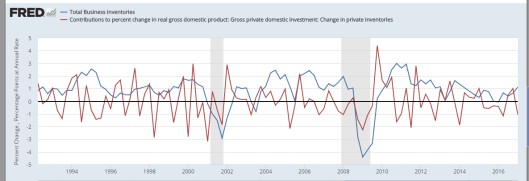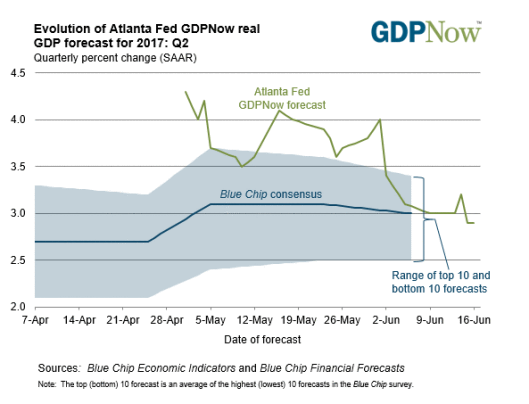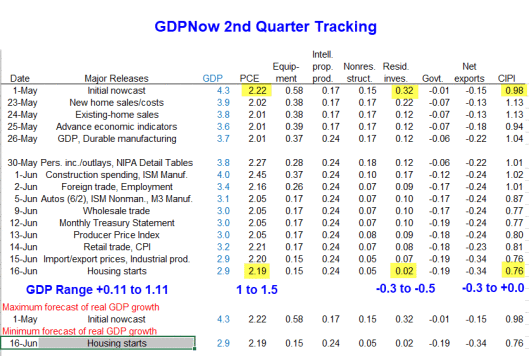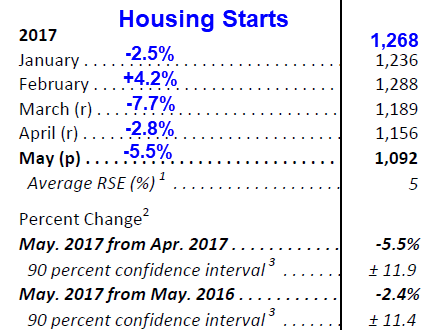In the first quarter of 2017, models that supposedly had a margin of error of one percentage point had more than two percentages points difference.
The discrepancy between GDPNow and the FRBNY Nowcast is “only” one percentage point now, but my own personal assessment of second quarter GDP differs from GDPNow by at least 1.8 percentage points.
Since less than half of the economic reports for the second quarter are in, I have a pretty wide range of estimates.
See Mish Preliminary Estimate for Second Quarter GDP: 0.1% to 1.1 on June 16
GDPNow Forecast: 2.9 percent — June 16, 2017
GDPNow Second-Quarter Tracking
Despite miserable housing numbers today, with negative revisions to last month, the GDPNow model still has residential investment positive albeit down from the initial estimate.
Starts will continue to add to GDP until they are completed, then consumers fill them with stuff. I fail to come up with residential investment adding to GDP.
Retail Sales
For the second quarter, retail sales are up 0.05 percent per month on average. With two of three months in (one preliminary), retail sales are up a total of 0.1%, roughly 0.6% annualized. GDPNow is looking for a 2.19 percentage point contribution, essentially the same as its initial forecast.
Business Inventories
There is only one month of data on business inventories (April), down 0.2%. Prior to the business inventory report, the Census bureau reported wholesale inventories were down 0.5%. I fail to see why inventories will add 0.76 percentage points. Unless inventories pick up, we are looking at a negative contribution.
I left all the other GDPNow numbers intact, but I have serious doubts about commercial construction as well.
Except for one industrial production report, economic data has been miserable this entire quarter.
We are not quite halfway through the reports and there may be huge revisions either way. But as it stands, I cannot come up with anything close to 2.9%.
We may be lucky to beat 1.0% the way things are going.
Change in Private Inventories (CIPI)
There are big discrepancies all around, but the largest difference between my estimate and GDPNow regards change in private inventories (CIPI).
I can make almost no sense out of CIPI.
One might think that changes in total business inventories would align with the BEA’s CIPI contribution to changes in GDP, but one would be seriously mistaken.
Percent Change in Total Business Inventories vs Inventory Change in GDP

If there is a consistent relationship between inventories and the BEA’s reporting of inventories in GDP I sure do not see it.
I pinged Pat Higgins at GDP now with the above chart and asked …
Hi Pat
I cannot make heads or tails out of change in private inventories.
What is going on?
This seems like a real crapshoot.
How does your model estimate CIPI contribution?
Thanks
Mish
Reply from Pat Higgins
Hi Mish
I’ve written some macroblog articles noting that, historically, inventory investment, has been difficult to predict both for GDPNow and professional forecasters. Please see:
For industries and months where there is monthly data released by the Census Bureau on the change in the book value of inventories, the model estimates the inventory valuation adjustment needed to construct the change in inventory investment that the BEA uses in its inventory calculations for GDP. See equation (17) of the paper.
For months beyond that, it forecasts the sum of the change in the book value and the inventory valuation adjustment directly for these industries. These industries with monthly Census Bureau data are combined with other industries that are forecasted in a variety of other ways described in the paper. The inventory forecasts are aggregated together into a “monthly model forecast”. There is also a quarterly Bayesian vector autoregression that makes another forecast of inventory investment. A weighted average of the two forecasts are used with the weight depending on the performance of the two models based on a regression. As more data is released, the weight on the monthly model goes up. Currently it’s weight is 0.69 and it’s forecast is a bit stronger than the quarterly BVAR model [43 billion ($2009) vs. 28 billion ($2009)]. You can see the details in the GDPNow tab “Inventories” . The monthly model is expecting increases in the change in inventory investment from both manufacturing and wholesalers but a drop from retail motor vehicle & parts dealers.
Once the level of real inventory investment is estimated, the contribution is estimated using the formulas on pages 37-38 of the paper.
Hope this helps.
Pat
Logical Analysis
Without diving into mathematical formulas, I can state what makes logical sense to me.
- Business inventories are lower, for good reason: sales are poor. See Business Inventories Sink (And Why Shouldn’t They?) Yellen Still Clueless?
- The value of any inventories of auto dealers new or used, should be declining.
- The value of any raw commodities held, especially crude should also be declining.
Based on the above, I estimated CIPI contribution to GDP at 0.0 to -0.3. The GDPNow model says +0.76.
Thus, on this one extremely volatile factor, and one that appears to be a crapshoot at that, I differ with GDPNow by 0.76 to 1.06 percentage points.
Two Wrongs Make a Right?
It is possible I totally blow the CIPI calculation.
If so, I have a possible cushion: residential housing sucks and so do retail sales. Both can be far worse than I estimated. That may balance out excess negativity on my CIPI forecast.
Moreover, I subtracted nothing at all for commercial real estate and I think that is generous.
In his May 22 article, GDPNow’s Second Quarter Forecast: Is It Too High? Higgins has some interesting comments:
We encourage—and frequently receive—feedback on our GDPNow tool, and some users have suggested that our forecast for second quarter growth is too high. In fact, some empirical evidence supports that view.
More than half of the difference between the GDP growth forecasts from GDPNow and the SPF [Survey of Professional Forecasters ] is due to inventories. For both forecasts, inventory investment also accounts for over half of the pickup in second quarter growth from the trailing four-quarter average.
Based on experience, we can’t be confident that either forecast of inventory investment is likely to be very accurate or that one is likely to be much more accurate than another.
Those clips are from a detailed article that is worth a much close look.
Once again, I thank Pat Higgins for his explanations and time. I hope to improve the model in some way with my comments.
On May 23, one day after the above article was written, the GDPnow model stood at 3.9%. It has since dropped one full percentage point.
For now, I am sticking with my June 16 forecast: Mish Preliminary Estimate for Second Quarter GDP: 0.1% to 1.1.
Mike “Mish” Shedlock



